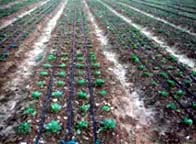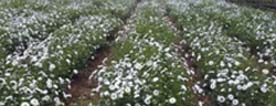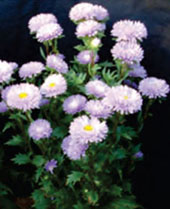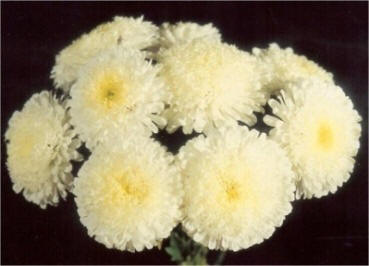cultivation practices
-
soil & climate
Aster performs well in an open sunny location. Well drained red loamy soil with pH around 6.0 is the best. Heavy soils with high calcium are not suitable. It is mainly a winter season flowering annual crop. Temperature range of 20-30oC during day and 15-17oC during night with relative humidity of 50-60% is the most suitable weather condition. It needs sufficient sunlight for better growth and flowering, limited rains of 500-700 mm spread over June to September, followed by provision of frequent but light irrigation. In Karnataka (Bangalore), it can be grown round the year, however, July-September planting is the most ideal.
-
propagation
Aster is propagated through seeds. The fresh seeds collected from disease free healthy plants should be used for raising nursery. The seeds can be stored in polythene bags and kept in cold storage at 2oC which will increase the viability to 24 months. The seed rate requirement is 625 g/ha.
-
Nursery raising
Seeds can be sown in seed pans for small quantities of seedlings. For commercial cultivation, seeds are sown in raised beds. The raised beds are prepared with fine mixture of red soil, sand and farm yard manure (1:1:1). Nursery beds are drenched with captan or dithane M-45 @ 2 g/l of water before sowing the seeds to avoid fungal diseases like damping off etc. Seedlings can also be raised in pro-trays with cocopeat as a substrate. Seeds are sown thinly about 0.5 cm deep in rows across the length at 10-12 cm apart and covered with a mixture of soil and farm yard manure. After sowing, beds should be covered with shade net (50%) and watered gently. After germination, shade net may be removed.
-
Field preparation

The field should be ploughed thoroughly and bought to a fine tilth. About 10-15 tones/ha of well decomposed farm yard manure may be mixed thoroughly in the soil at the time of field preparation. In areas receiving high rainfall, the seedling should be transplanted on ridges to avoid water logging.
-
Transplanting

About 30 day-old seedlings are usually transplanted when they have developed about three to four leaves. A spacing of 30 cm between plant to plant and row to row is recommended. The transplanting should be done preferably during early morning or evening to avoid bright sunshine.
-
Fertilizer requirement
Application of manures and fertilizers in required quantities is important for proper growth, yield and quality of flowers. In Bengaluru, the recommended fertilizer dose is 90 kg nitrogen, 60 kg phosphorus and 60 kg potash per hectare which should be applied at the time of field preparation. A top dressing of nitrogen at 90 kg/ha 40 days after transplanting proved beneficial.
-
Irrigation
Irrigation requirement depends upon the weather, type of soil and season of the crop grown. Since China aster is a shallow rooted crop, it requires irrigation at an interval of 3 to 7 days depending on soil moisture. Drip irrigation will help in better crop growth and also saves irrigation water.
-
Pinching

Pinching of main shoot at one month after transplanting increases number of nodes, branches, flowers per plant and flower yield per unit area.
-
inter-cultivation
Regular hand weeding may be done in early stages of crop growth. Loosenning the soil for better aeration helps in increasing the crop growth. Two earthing up operations at an interval of one month helps in luxurious growth and gives proper support to the plant to avoid lodging.
-
Harvesting & yield
China aster is harvested in two ways. Individual flowers are harvested for decoration and worship purpose whereas flowers along with stalk or whole plant is harvested when 60 per cent flowers are fully opened. The flowers are generally harvested in the early morning or late evening. With improved package of practices, a yield of 18 to 20 tons/ha can be obtained.

 China aster [Callistephus chinensis (L.) Nees] is a
flowering annual belongs to the family Asteraceae and is
a native of China. It spread to Europe and other
tropical countries during 1731.
China aster [Callistephus chinensis (L.) Nees] is a
flowering annual belongs to the family Asteraceae and is
a native of China. It spread to Europe and other
tropical countries during 1731.